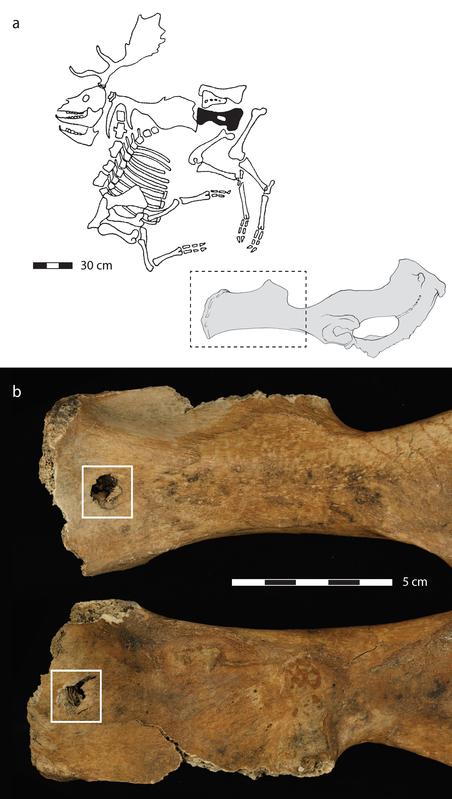Neandertals practiced close-range hunting 120,000 years ago
In the journal Nature Ecology and Evolution an international team of scientists reports the oldest unambiguous hunting lesions documented in the history of humankind. The lesions were found on skeletons of two large-sized extinct fallow deer which were killed by Neandertals ca. 120,000 years ago, around the shores of a small lake (Neumark-Nord 1), near present day Halle in the eastern part of Germany. The study constitutes a significant step forward in our knowledge of the Neandertal niche: it demonstrates how Neandertals obtained their prey, first and foremost in terms of their much debated hunting equipment while also shedding light on their hunting skills.
With an innovative experimental ballistic setup that includes state of the art motion-sensor technology, the specific form of one of the lesions was reproduced with a wooden thrusting spear that impacted with low velocity. This suggests that Neandertals approached animals very closely and thrusted, not threw, their spears at the animals, most likely from an underhand thrusting angle. Such a confrontational way of hunting required careful planning and concealment and close cooperation between individual hunters.
The ballistic experiments were conducted at the Archaeological Research Centre and Museum of Human Behavioural Evolution MONREPOS, an institution of the Leibniz-Researchinstitute for Archaeology Römisch-Germanisches Zentralmuseum (RGZM). Furthermore, the Institute of Robotics and Intelligent Systems of ETH Zurich and the Archaeological Faculty of the University of Leiden participated in the study.
The lake where the hunts took place was surrounded by a close canopy forest, a type of environment which is deemed particularly challenging for hunter-gatherers, even modern human ones. Interestingly, the excavations in the Neumark-Nord area have yielded tens of thousands of bones of large mammals (including red and fallow deer, horses, bovids) as well as thousands of lithic artefacts from this uniquely rich Last Interglacial lake landscape, attesting to the success of Neandertal survival in forested environments.
Although hominins most likely started hunting with weapons more than half a million years ago, actual evidence on how wooden spear-like objects like those found at Clacton (UK), Schöningen and Lehringen (both in Germany) were used was absent prior to the identification of the Neumark-Nord hunting lesions. As far as spear use is concerned, we now finally have the ‘crime scene’ fitting to the proverbial ‘smoking gun’. "As part of our research focus on nutrition, we have been analysing hunting strategies and weapon technologies of early humans for years," explains Professor Dr. Sabine Gaudzinski-Windheuser, head of the Archaeological Research Centre and Museum for Human Behavioural Evolution MONREPOS, the Pleistocene and Early Holocene Archaeology competence area at the RGZM. And she continues: “The traces we found on the fallow deer skeletons provide further, valuable information on the use of weapons by Neanderthals and give us an insight into the use of spears comparable to those found at the 300,000-year-old site of Schöningen, which were preserved in the restoration workshops of the RGZM in 2010.”
The article has been published in: Nature Ecology and Evolution (25 June 2018)
Sabine Gaudzinski-Windheuser et al
Evidence for close-range hunting by last interglacial Neanderthals
DOI: 10.1038/s41559-018-0596-1.
Contact details for further information:
Prof. Dr. Sabine Gaudzinski-Windheuser (MONREPOS Archäologisches Forschungszentrum und Museum für menschliche Verhaltensevolution, Römisch-Germanisches Zentralmuseum, Leibniz-Forschungsinstitut für Archäologie und Johannes Gutenberg-Universität Mainz) (corresponding author)
gaudzinski@rgzm.de
Elisabeth S. Noack (MONREPOS Archäologisches Forschungszentrum und Museum für menschliche Verhaltensevolution und Johannes Gutenberg-Universität Mainz)
noack@rgzm.de
Prof. Dr. Wil Roebroeks (Archäologische Fakultät der Universität Leiden): w.roebroeks@arch.leidenuniv.nl
Dr. Eduard Pop (MONREPOS Archäologisches Forschungszentrum und Museum für menschliche Verhaltensevolution und Archäologische Fakultät der Universität Leiden)
e.pop@rgzm.de
Prof. Dr. Jonas Buchli (Agile and Dexterous Robotics Lab, Institut für Robotik und Intelligente Systeme, ETH Zürich)
buchlij@ethz.ch
Dr. Johannes Pfleging (Agile and Dexterous Robotics Lab, , Institut für Robotik und Intelligente Systeme, ETH Zürich)
pfleginj@ethz.ch
High Resolution pictures:
https://cloud.rgzm.de/index.php/s/PScBcGvSYiflbrb
Figure 1
Front and back view of a hunting lesion in the pelvis of an extinct fallow deer, killed by Neandertals 120,000 years ago on a lake shore close to current-day Halle (Germany). Picture credit: Eduard Pop, MONREPOS Archaeological Research Centre and Museum for Human Behavioural Evolution, Römisch-Germanisches Zentralmuseum, Leibniz-Researchinstitute for Archaeology
Figure 2
Front and back view of a hunting lesion in a cervical vertebra of an extinct fallow deer, killed by Neandertals 120.000 years ago on a lake shore close to current-day Halle (Germany).
Picture credit: Eduard Pop, MONREPOS Archaeological Research Centre and Museum for Human Behavioural Evolution, Römisch-Germanisches Zentralmuseum, Leibniz-Researchinstitute for Archaeology
Figure 3
Micro-CT scans of the lesion in the pelvis of a fallow deer, killed 120,000 years ago on a lake shore close to current-day Halle (Germany). The screenshots show lesion and reconstructed form of the pointed object (spear) which caused the perforation, seen from its exit side.
Pictures credit: Arne Jacob & Frieder Enzmann, Johannes Gutenberg-University Mainz, Germany
Figure 4
Estimated impact angle shown in relation to a standing fallow deer for the hunting lesion observed in the pelvis of an extinct fallow deer, killed by Neandertals 120,000 years ago on a lake shore close to current-day Halle (Germany).
Picture credit: Eduard Pop, MONREPOS Archaeological Research Centre and Museum for Human Behavioural Evolution, Römisch-Germanisches Zentralmuseum, Leibniz-Researchinstitute for Archaeology
Figure 5
Skeleton of an extinct fallow deer (Dama dama geiselana) from Neumark-Nord, arranged in flight-posture. Foto Juraj Lipták. © Landesamt für Denkmalpflege und Archäologie Sachsen-Anhalt, Juraj Lipták
Figure 6
Excavation of a 120.000 last Interglacial lake-landscape at Neumark-Nord near present day Halle in the eastern part of Germany by the Archaeological Reserch Centre and Museum for Human Behavioural Evolution MONREPOS and the Faculty of Archaeology of Leiden University supported by supported by the heritage office of Saxony Anhalt (Germany).
Picture credit: W. Roebroeks, Leiden University (NL)
Figure 7
A 300.000 year of wooden spear from Schöningen 13/II (Germany). Neandertals might have used a similar weapon to kill fallow deer at Neumark-Nord, on a lake shore close to current-day Halle (Germany), 120.000 years ago. © R. Müller, Römisch-Germanisches Zentralmuseum, Leibniz-Forschungsinstitut für Archäologie
Weitere Informationen:
https://web.rgzm.de/en/about-us/press-area/press-releases/news-details/article/hieb-und-stichfest-so-jagten-neandertaler-vor-120000-jahren/
Die semantisch ähnlichsten Pressemitteilungen im idw



